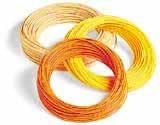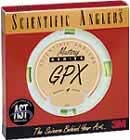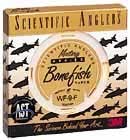Fly Fishing with Doug Macnair: All About Lines: Part 3©
Fly Fishing with Doug Macnair: All About Lines: Part 3©
From his manuscript, Fly Fishing for the Rest of Us
 Before unlocking the secret to the fly line codes, allow me to update, correct and reinforce a couple of points. Until I was well into writing this article, I wasn’t aware that Airflo is unique in not using PVC in their line coating. According to Main Stream Angling, the exclusive U. S. distributor for Airflo, these fly lines, as well as their PolyLeaders and PolyTips, wear a tough polymer coating for enhanced shooting characteristics. Importantly, the line’s design minimizes the memory problem in cool water and cold weather.
Before unlocking the secret to the fly line codes, allow me to update, correct and reinforce a couple of points. Until I was well into writing this article, I wasn’t aware that Airflo is unique in not using PVC in their line coating. According to Main Stream Angling, the exclusive U. S. distributor for Airflo, these fly lines, as well as their PolyLeaders and PolyTips, wear a tough polymer coating for enhanced shooting characteristics. Importantly, the line’s design minimizes the memory problem in cool water and cold weather.
A Summary of Key Points. At this point in our ongoing discussion, it’s appropriate to summarize and reinforce several points worthy of your consideration as you go about selecting a fly line.
- I recommend you begin your fly fishing experience using either a weight-forward or a double-taper floating line. Floaters are a learner’s delight. First off, floaters are easier to cast than any of the others. Of the two, I favor the double-taper, especially when casting a 6-weight or less. As an alternative, consider a Triple Taper floater. The reason? I think you should learn the roll cast early-on, not later after you become an "X-Spurt" (whatever that is). I’m sure others will suggest that the weight-forward line is the first weapon of choice. However, I doubt those advocating this preference are concerned with anything other than the standard overhead cast. If you are just getting started, I don’t think you will appreciate the differences between the two, and the double-taper and/or the Triangle Tapers have the edge in roll casting. Importantly, the roll cast should be mastered long before undertaking things like "shooting line" or doing the gyrations of the "double-haul." Become concerned with these techniques only after mastering the basics -- the standard overhead and roll cast. Those that heed these words will progress rapidly; those that don’t, won’t! Listen to my advice and there will come a day when you will delight in the knowledge that a double-taper line is in your bag of tricks!
- Keep in mind that the only thing constant in the gentle art of fly fishing is the AFTMA standard for fly line weights. Consequently, only fly lines can be discussed objectively; everything else, including the rods, is subjective. This implies choosing the line weight should be your priority when setting up a new fly fishing rig. It’s fairly simple to select the right line weight for the task if you identify: (1) the primary species you plan to pursue; (2) the type waters you plan to fish; (3) the climatology of the region; and (4) the size of the flies, streamers or bugs you intend to throw.
- Choose a larger line weight to throw a larger fly. It’s the mass of the fly line that pulls along the mass of the fly. Select the right gun (line) to do the job. The same is true for the rod. Don’t let the esthetics of a slender lovely little 3-weight rod throw you into a tizzy when a 7-weight is what you need. Of course, if you are into buying lots of fly rods, be my guest.
- Don’t overline! Overlining is a silly "phenomenon" that occurs when a fly fisher selects a heavier line - say a 7-weight floater - to use on a 6-weight rod. Dummies do that because some jackass said, "it will cast better." It won’t! While it’s possible for a rod to be rated incorrectly, it is indeed rare. The notion of overlining is "crapola" propagated by either those (a) who cannot cast, (b) those who do not know much about fly fishing, or the cons who want you to think you are a "fly caster" within the first 5 minutes. I detest cons! The fact that he or she may sell fly fishing equipment means zilch in terms of creditability! There is a single exception to this statement -- it’s "short-range" casting to targets under 30 feet. In this instance, it’s true that a 7-weight floater will load a 6-weight rod to cast 30 feet or less. However, if you learn to tip cast, overlining for this specific situation becomes unnecessary.
- If you happen to be a Doubting Thomas, consider this -- 30 feet of fly line weighing 140 grains outside the rod tip is a 5-weight line by definition in the AFTMA standards. Add another 5 feet to the length, and what do you have? The 35-feet of 5-weight line now weighs the equivalent of a 6-weight. The simple fact is adding 5 feet of line, in effect, adds one line weight. Said another way, aerializing 35 feet of 5-weight line on the backcast is the equivalent of lifting 30-feet of 6-weight line into the air! No question about it -- you need to understand the idiosyncrasies of line weights and how they can work for or against you. In the heavier weights - 8, 9 and 10 - I often recommend using a rod weighted one weight above the line weight to be fished. For now, perhaps this example will suffice: When I demonstrate "Long Casting," I use a 10-weight line on a "light" 12-weight rod called WindTamer. (The term WindTamer is mine having first published it in May, 1995.) And yes, you read it correctly -- the rod is two line weights heavier than the line; and no, I am not embellishing facts. As an old Druid, I speak truthspeak! More on this subject later.
- Most rods will cast more than one line weight. Some might do it better than others, but normally you can count on at least two line weights for almost any rod, down but nor necessarily up. You might even find your 7-weight will cast a 3 or 4-weight line well enough to catch fish. This usually works best using a technique I call tip casting. True, you may not be able to perfectly emulate what can be done with a 3-weight system, but you will catch fish, have fun and save money, if that’s important.
 The Line Codes. With these points behind us, the way is cleared to break the codes. Actually, you don’t need a Lone Ranger Magic Decoder Ring as long as you remember the way the codes are setup. The first 2 alphabetic letters describe the taper: WF - Weight-Forward; DT - Double-Taper; TT - Triangle Taper; and ST - Shooting Taper. The line weight follows next with a numeral designation from 1 to 15. Following the line weight is the third and final part: F for floating, S for sinking and S/T for sink-tip. Here are some examples:
The Line Codes. With these points behind us, the way is cleared to break the codes. Actually, you don’t need a Lone Ranger Magic Decoder Ring as long as you remember the way the codes are setup. The first 2 alphabetic letters describe the taper: WF - Weight-Forward; DT - Double-Taper; TT - Triangle Taper; and ST - Shooting Taper. The line weight follows next with a numeral designation from 1 to 15. Following the line weight is the third and final part: F for floating, S for sinking and S/T for sink-tip. Here are some examples:
(1) DT-4-F stands for: Double-Taper, 4-Weight, Floating.
(2) ST-8-S stands for: Shooting Taper, 8-Weight, Sinking.
(3) WF-9-S/T stands for: Weight-Forward, 9-Weight, Sink-Tip.
(4) TT-7-F stands for: Triangle Taper, 7-Weight, Floating.
That’s all there is to the magic of line codes. Follow the logic in reading from left to right and you won’t have a problem. It’s true, however, the line codes alone will not suggest the optimum use for any particular line. Whether for saltwater or fresh, general purpose or specialty, look for the manufacturers’ further comments on the package. When it comes to fly lines, I can do no more than recommend obtaining the product literature the manufacturers make available. It is a terrific way of learning about their fly lines and is usually at zero cost to you. As an example, Scientific Anglers has an excellent catalog clearly illustrating fly line construction with superb graphics well beyond my humble capabilities. A contact list follows:
(1) AirFlo (Main Stream Angling), 1 (888) 672-6866.
(2) Cortland, 1 (800) 847-6787.
(3) Fenwick, 1 (714) 897-1066.
(4) McKenzie, 1 (541) 741-8161.
(5) Orvis, 1 (800) 548-9548.
(6) RIO, 1 (208) 785-1244.
(7) Royal Wulff, 1 (914) 439-4060.
(8) Scientific Anglers, 1 (800) 525-6290.
(9) Teeny Nymph, 1 (503) 667-6602.
 I am certain any of these folks will be happy to furnish details regarding their products. Please mention this column when you call or write. It helps them know someone on the internet is trying to keep you, the fly fisher, stay abreast and informed of who’s who and what’s what in fly fishing -- including innovations and developments in technology.
I am certain any of these folks will be happy to furnish details regarding their products. Please mention this column when you call or write. It helps them know someone on the internet is trying to keep you, the fly fisher, stay abreast and informed of who’s who and what’s what in fly fishing -- including innovations and developments in technology.
A Criteria for Fly Line Selection. When considering my needs in a new fly line, I think about four terms: castability, shootability, visibility and durability. It’s a notion you may find useful.
(1) Castability: I think of castability as the smooth carry and control of the fly line during the cast. Inevitably, the choice comes down to turnover power or delicacy of presentation. The choice is yours.
(2) Shootability: Shootability, in my view, depends on the tradeoff between slickness, stiffness and locale. As already discussed, lines created for the tropics become stiff with "coil" memory in cool waters. The reverse is equally bad. The wrong line in the right water will not shoot!
(3) Visibility. It’s the age-old debate: "To see or not to see, that is the question." While perhaps profound in philosophy, seeing is the better of the two alternatives. Advanced fly casting requires the magic of sight to gauge timing. The notion that "feel" should govern the cast, is simply more "crapola." It’s a notion propagated by old folks who learned fly casting in the days of Cro-Magon Man when limb and vine were the tackle of the time. Fortunately, those days have passed. Being able to "feel" the cast is neat; being able to watch it is even better. To see your cast, you must be able to see the fly line. Therefore, I recommend using a high visibility color. And yes, I know all about the crystal-clear beaver pond in the high country of Colorado that’s loaded with Golden Trout. I have fished it! I never did figure out how to make the tippet, leader, line, rod, reel and me invisible. I guess those fish will live forever.
(4) Durability. Durability rests in the tender loving care the manufacturer imparts to the coating. If caring for your equipment is of no value, go the inexpensive route and buy a new line every six months or so; if you care for your equipment, buy the best. You will never regret the decision. I’ve said it before and I will say it again: The fly line is the most important part of the fly fishing rig.
 Next up: It’s a discussion of the shooting tapers, or as the line code would indicate, the story of the ST. I think you will find it interesting and well worth your time. Who knows, it may prove of sufficient intrigue to make you a follower. After all, fly fishing is about catching fish, not going fish-less. God Bless.
Next up: It’s a discussion of the shooting tapers, or as the line code would indicate, the story of the ST. I think you will find it interesting and well worth your time. Who knows, it may prove of sufficient intrigue to make you a follower. After all, fly fishing is about catching fish, not going fish-less. God Bless.
© Copyright: Douglas G. Macnair, 1997.
|
